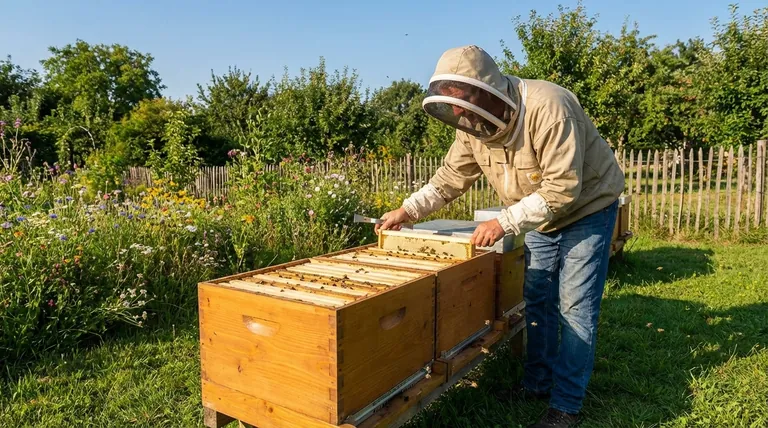In short, the primary benefits of horizontal hives are the complete elimination of heavy lifting and dramatically simplified hive inspections. This design places all the frames on a single level, meaning you never need to lift heavy boxes (supers) to check on the colony's health or to access honey frames, making beekeeping accessible to people of all physical abilities.
The decision to use a horizontal hive is fundamentally a choice of beekeeping philosophy. It prioritizes the beekeeper's physical comfort and a less-intrusive management style over the modularity and maximized honey production potential of vertical hives.

The Core Principle: A Single-Level System
To understand the benefits of a horizontal hive, you must first contrast it with its vertical counterpart, the common Langstroth hive.
How a Vertical Hive Works
A vertical hive, like the Langstroth, is a modular system of stacked boxes. The bottom boxes are for the brood (where the queen lays eggs), and upper boxes, called supers, are added for honey storage.
Managing this system involves lifting. To inspect the brood, you must lift off all the honey supers above it, which can weigh 50-80 pounds (23-36 kg) each.
How a Horizontal Hive Works
A horizontal hive is a single, long box. It contains all the frames—for both brood and honey—on one level.
The colony starts at one end and expands sideways into the empty space. You never add or remove boxes, only individual frames. This single design choice is the source of all its primary benefits.
Key Benefit 1: No Heavy Lifting
This is the most significant advantage and a primary reason beekeepers choose this style.
Accessibility for Everyone
Because you never lift anything heavier than a single frame of honey or brood, beekeeping becomes possible for those with back problems, limited strength, or other physical constraints.
Safer and Less Strenuous Work
Even for those who can lift heavy boxes, avoiding it reduces strain and makes the work of beekeeping calmer and more enjoyable. There is less risk of dropping a heavy box, which is dangerous for both you and the bees.
Key Benefit 2: Simplified Inspections
Inspections are quicker and less disruptive to the colony in a horizontal hive.
Direct Access to the Brood Chamber
To check on your queen and the health of the brood, you simply open the lid and remove the frames you want to see. You do not have to deconstruct a tower of boxes to reach the bottom.
Less Disruption to the Bees
Lifting supers off a vertical hive breaks the propolis seals the bees have made and disturbs the entire colony. A horizontal hive inspection is a much more localized and less stressful event for the bees.
Understanding the Trade-offs
The simplicity of the horizontal hive comes with important limitations that you must consider.
Fixed, Limited Size
A horizontal hive's greatest weakness is its fixed size. Once the bees fill the entire box, there is no way to add more space. This can limit the colony's ultimate population and its potential for a massive honey harvest.
In contrast, a vertical hive is infinitely expandable; you can always add another super.
Potentially Lower Honey Yields
Because they are not designed for aggressive expansion, horizontal hives are not typically used for maximizing honey production. While they produce plenty of honey for personal use, commercial operations almost exclusively use vertical hives for their higher yield potential.
Lack of Modularity and Standards
The Langstroth hive is the dominant standard. This means its parts are interchangeable, cheap, and widely available. Horizontal hives, like the Layens or Top-Bar, are less standardized, and finding compatible equipment can sometimes be more challenging.
Making the Right Choice for Your Goals
Your beekeeping goals should dictate your choice of hive. There is no single "best" type—only the best type for you.
- If your primary focus is accessibility and a low-strain, less-intensive hobby: The horizontal hive is an outstanding choice that removes the greatest physical barrier to beekeeping.
- If your primary focus is maximizing honey production or you want a scalable system with widely available parts: The standard vertical Langstroth hive is the more practical and productive option.
Ultimately, choosing a horizontal hive is about aligning your equipment with your personal philosophy and physical capabilities.
Summary Table:
| Benefit | Description |
|---|---|
| No Heavy Lifting | Single-level design means you only lift individual frames, not heavy supers. |
| Simplified Inspections | Direct access to the brood chamber makes hive checks quicker and less disruptive. |
| Enhanced Accessibility | Ideal for beekeepers with physical constraints or those seeking a less strenuous hobby. |
| Less Stress on Bees | Inspections are localized, causing less disturbance to the colony compared to vertical hives. |
Ready to experience the ease of horizontal beekeeping?
At HONESTBEE, we supply commercial apiaries and beekeeping equipment distributors with the high-quality, durable horizontal hive equipment needed for a more accessible and manageable operation. Our wholesale-focused solutions help you provide the best tools for beekeepers who prioritize comfort and a less-intensive management style.
Contact our team today to discuss your wholesale needs and discover how HONESTBEE can support your business.
Visual Guide

Related Products
- HONESTBEE Professional Long Handled Hive Tool with Precision Cutting Blade
- Long Langstroth Style Horizontal Top Bar Hive for Wholesale
- HONESTBEE Advanced Ergonomic Stainless Steel Hive Tool for Beekeeping
- HONESTBEE Professional Multi-Functional Hive Tool with Ergonomic Wood Handle
- Multi-Function Plier-Style Frame Grip Hive Tool
People Also Ask
- What are some common uses of a hive tool? Essential Multi-Purpose Tool for Every Beekeeper
- Why do hive tools have a hole? Unlock the Secret to Efficient Beekeeping
- What is a hive tool and what are its uses? Master Your Hive Inspections with the Essential Beekeeper's Tool
- What tools are used for cleaning frames? A Beekeeper's Simple 4-Tool Guide
- What is a hive tool used for in beekeeping? Your Essential Guide to Hive Management



















